How Optimizing for Voice is Transforming SEO Strategies in 2025
Key Highlights
- Voice search is projected to account for over 50% of all searches by 2025, fundamentally changing how users discover content online
- Voice queries are typically longer, more conversational, and often phrased as questions, requiring a shift in keyword strategy
- Local businesses see the greatest impact from voice search optimization, with 58% of consumers using voice to find local information
- Mobile optimization is no longer optional, as the majority of voice searches occur on smartphones and other mobile devices
- Structured data and schema markup have become essential for helping voice assistants understand and feature your content
- Voice commerce is projected to reach $80 billion annually by 2025, creating new revenue opportunities for businesses that optimize effectively
TABLE OF CONTENTS:
The digital landscape is experiencing a profound transformation as voice search technology continues its meteoric rise. What began as a novelty feature has evolved into a fundamental shift in how people interact with search engines and discover information online. In 2025, voice search isn’t just an alternative to traditional text-based searches—it’s becoming the globally preferred method for millions of users.
According to recent projections, voice search is expected to account for over 50% of all searches by the end of 2025. This dramatic shift is driven by the increasing sophistication of voice assistants like Google Assistant, Apple’s Siri, and Amazon’s Alexa, along with the growing ubiquity of smart speakers, smartphones, and other voice-enabled devices.
What does this mean for businesses and marketers? This evolution represents both a challenge and an opportunity. Those who adapt their SEO strategies to accommodate voice search will gain a significant competitive advantage, while those who cling to outdated approaches risk becoming increasingly invisible to a growing segment of their potential audience.
In this comprehensive guide, we’ll explore how optimizing for voice is transforming SEO strategies in 2025 and provide actionable insights to help you navigate this changing landscape.
The Fundamental Shift in Search Behavior
The rise of voice search has catalyzed a fundamental shift in how people interact with search engines. Unlike traditional text-based searches, which often consist of abbreviated keyword phrases (“best coffee shop NYC”), voice searches tend to be longer, more conversational, and frequently structured as complete questions (“What’s the best coffee shop in downtown Manhattan?”).
This shift is reflected in the data: the average voice search query contains 29 words, compared to just 3-4 words for the average text search. This dramatic difference in query length and structure necessitates a complete rethinking of SEO strategies that were built around short, fragmented keyword phrases.

Moreover, voice search has changed user expectations regarding search results. When people use voice search, they typically expect immediate, concise answers rather than a list of links to explore. This preference for direct answers has contributed to the rise of zero-click searches, where users get the information they need directly from the search results page without clicking through to a website.
The impact of this behavioral shift varies across demographics, but adoption is strong across all age groups. While millennials lead voice search usage at 65%, even baby boomers show significant adoption rates of around 37%. This broad demographic appeal underscores the importance of voice search optimization as a universal SEO strategy rather than one targeted at specific audience segments.
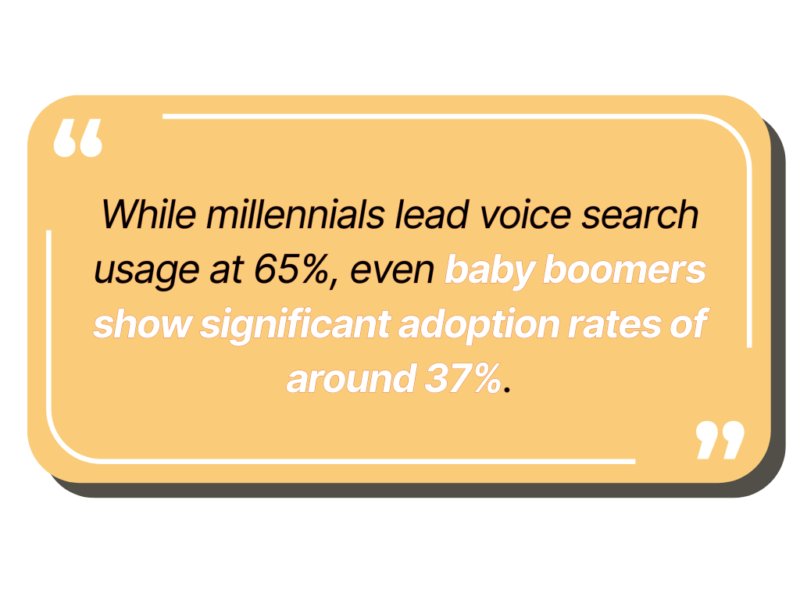
Conversational Keywords: The New SEO Currency
The conversational nature of voice search has transformed keyword research and strategy. Traditional keyword approaches focused on short, often grammatically incorrect phrases must now expand to include natural language patterns that mirror how people actually speak.
Long-tail, conversational keywords have become the new currency of SEO in the voice search era. These extended phrases typically have lower search volumes individually but collectively represent a significant portion of search traffic. More importantly, they often indicate higher intent and can drive more qualified traffic to your site.
Question-based queries have particular significance in voice search optimization. Keywords that begin with who, what, when, where, why, and how should be central to your voice search strategy. Research shows that “how” and “what” questions dominate voice searches, accounting for nearly 50% of all voice queries.
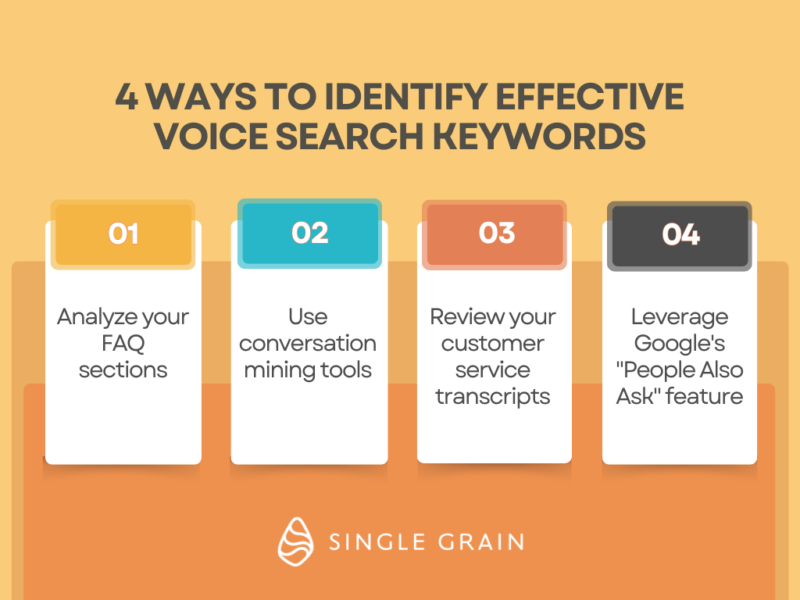
To identify effective voice search keywords, consider these approaches:
- Analyze your FAQ sections: What questions are your customers already asking? These provide natural starting points for voice search optimization.
- Use conversation mining tools: Tools like AnswerThePublic and BuzzSumo’s Question Analyzer can help identify question-based queries related to your industry.
- Review your customer service transcripts: Direct conversations with customers often reveal the natural language they use when asking about your products or services.
- Leverage Google’s “People Also Ask” feature: This provides insight into related questions users are asking about your topic.
When implementing voice search keywords, it’s important to maintain a natural, conversational tone. Awkwardly forcing question phrases into your content can be counterproductive. Instead, create content that naturally addresses these questions in a conversational manner.
A balanced approach that accommodates both traditional and voice search keywords is ideal. While voice search is growing rapidly, text-based searches remain significant and should not be neglected in your overall SEO strategy.
Local SEO: The Voice Search Amplifier
If there’s one area where voice search has had an outsized impact, it’s local search. Studies show that local searches dominate voice queries, with “near me” searches growing exponentially year over year. In fact, 58% of consumers report using voice search to find information about local businesses.

This local focus makes sense given the context in which many voice searches occur. Users often conduct voice searches while driving, walking, or otherwise on the go—precisely the moments when they’re looking for nearby businesses or services.
The rise of hyper-local targeting is a direct response to this trend. In 2025, optimizing for neighborhood-level searches has become essential, particularly for businesses in urban areas. Rather than simply targeting “coffee shop Chicago,” successful voice search strategies now target more specific phrases like “coffee shop in Wicker Park with free WiFi.”
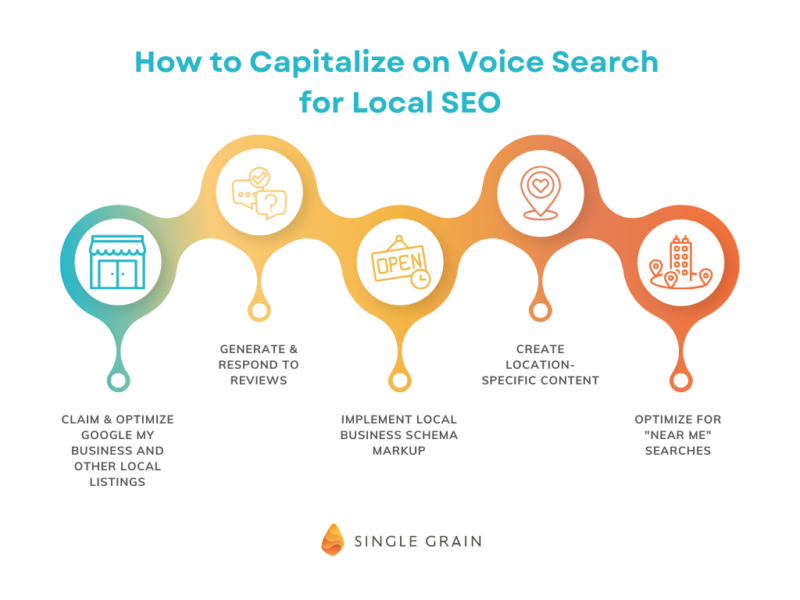
To capitalize on this trend, businesses should:
- Claim and optimize Google My Business and other local listings: Ensure your business information is accurate and complete, including name, address, phone number, business hours, and category.
- Generate and respond to reviews: Voice assistants often prioritize highly-rated businesses, and review content provides additional semantic context for voice search algorithms.
- Implement local business schema markup: Structured data helps voice assistants understand your business type, location, hours, and other critical information.
- Create location-specific content: Develop pages or blog posts that address location-specific topics and questions relevant to your local audience.
- Optimize for “near me” searches: Even though users say “near me,” you should focus on location-specific keywords rather than the phrase “near me” itself.
Local businesses that have embraced voice search optimization have seen remarkable results. For example, a Chicago-based dental practice reported a 27% increase in new patient appointments after implementing a voice search strategy focused on neighborhood-specific keywords and question-based content addressing common dental concerns.
Technical Foundations for Voice Search Success
The technical aspects of your website play a crucial role in voice search optimization. As voice searches predominantly occur on mobile devices, mobile optimization has become non-negotiable for voice search success.
Page speed is particularly critical for voice search rankings. Google and other voice assistants prioritize fast-loading pages that can deliver information quickly. Research indicates that pages that load in less than three seconds are significantly more likely to appear in voice search results.
Structured data and schema markup have become essential tools for voice search optimization. By implementing schema markup, you provide voice assistants with clear, machine-readable information about your content, making it easier for them to identify and present your content in response to relevant voice queries.
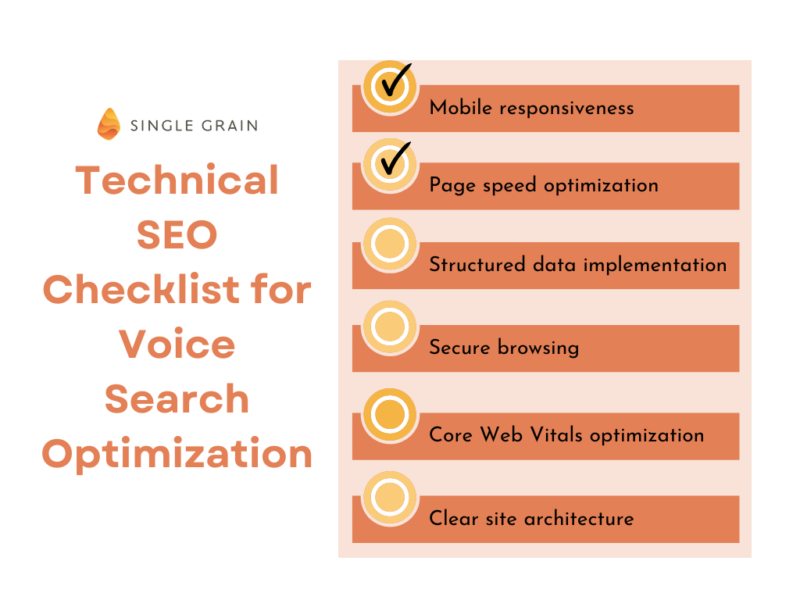
A comprehensive technical SEO checklist for voice search optimization should include:
- Mobile responsiveness: Ensure your site displays and functions properly on all mobile devices.
- Page speed optimization: Compress images, leverage browser caching, minimize code, and consider implementing AMP (Accelerated Mobile Pages) for critical content.
- Structured data implementation: Use schema.org markup for local business information, FAQs, how-to content, and other relevant data types.
- Secure browsing: Maintain HTTPS protocol across your entire site.
- Core Web Vitals optimization: Focus on Largest Contentful Paint (LCP), First Input Delay (FID), and Cumulative Layout Shift (CLS) metrics.
- Clear site architecture: Implement a logical, hierarchical structure that makes it easy for search engines to crawl and understand your content.
The impact of Core Web Vitals on voice search rankings cannot be overstated. These user experience metrics have become increasingly important ranking factors, with voice search algorithms showing a strong preference for pages that deliver excellent user experiences as measured by these metrics.
Content Strategies for Voice Search Dominance
Creating content that aligns with voice search queries requires a somewhat different approach than traditional SEO content. The most effective voice search content strategies center around directly answering specific questions that users are likely to ask.
FAQ sections have emerged as one of the most powerful content formats for voice search optimization. These sections naturally align with the question-based nature of voice queries and provide the concise, direct answers that voice assistants prefer. Structuring your FAQ content with proper schema markup further increases the likelihood of your content being featured in voice search results.
Featured snippet optimization is another critical aspect of voice search content strategy. Voice assistants frequently pull their answers from featured snippets (the “position zero” results that appear above the organic search listings). Content that is structured to win featured snippets—with clear, concise answers to specific questions—is well-positioned for voice search success.
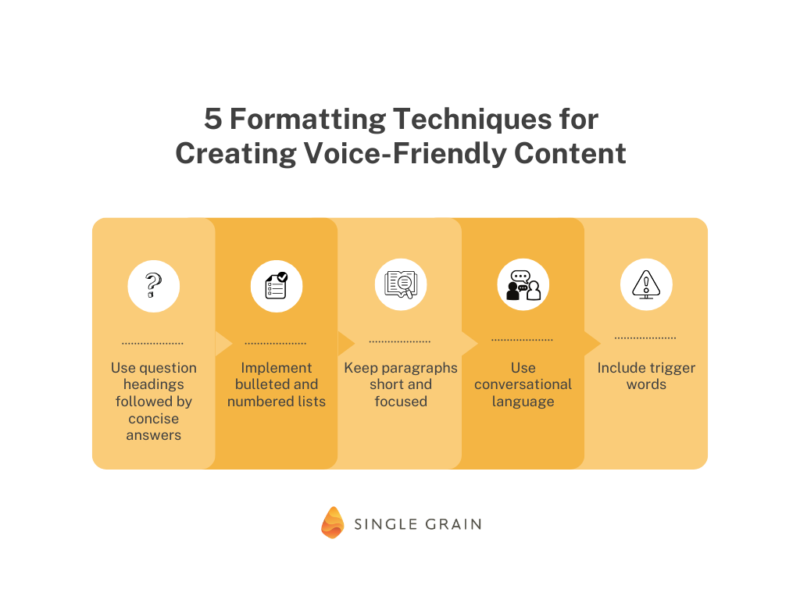
When creating voice-friendly content, consider these formatting techniques:
- Use question headings followed by concise answers: This structure mirrors the question-and-answer format of voice searches.
- Implement bulleted and numbered lists: Voice assistants often prefer content that is organized in clear, structured lists.
- Keep paragraphs short and focused: Concise paragraphs that directly address specific questions are more likely to be selected as voice search results.
- Use conversational language: Write in a natural, conversational tone that matches how people actually speak.
- Include trigger words: Phrases like “how to,” “what is,” and “the best way to” can help signal to voice assistants that your content directly answers common questions.
The challenge with voice search content is balancing comprehensiveness with concision. While voice assistants prefer direct, concise answers, Google’s overall algorithm still rewards in-depth, thorough content. The solution is to provide concise answers near the top of your content while exploring the topic more comprehensively throughout the rest of the page.
Voice Commerce: The Next Frontier
One of the most exciting developments in the voice search landscape is the rapid growth of voice commerce. With voice-enabled purchasing projected to reach $80 billion annually by 2025, businesses that optimize for voice commerce stand to gain a significant competitive advantage.
Voice commerce represents a natural evolution of e-commerce, allowing consumers to make purchases through voice commands without the need to navigate websites or apps manually. This frictionless purchasing process is particularly appealing for repeat purchases, subscriptions, and products with straightforward buying decisions.
For e-commerce businesses, preparing for voice commerce involves several key strategies:
- Optimize product descriptions for voice search: Use natural language that addresses specific questions shoppers might ask about your products.
- Implement product schema markup: Structured data helps voice assistants understand product details, pricing, availability, and reviews.
- Create voice-friendly navigation paths: Develop clear, logical category structures that can be easily navigated through voice commands.
- Build voice apps or skills: Consider developing custom voice applications for platforms like Alexa or Google Assistant that facilitate purchasing directly through voice commands.
- Focus on reordering functionality: Make it easy for customers to reorder products they’ve purchased previously through simple voice commands.
Personalization plays a crucial role in voice commerce success. Voice assistants are increasingly capable of providing personalized recommendations based on past purchases, browsing history, and stated preferences. Businesses that leverage this personalization capability can significantly enhance the voice shopping experience for their customers.
For businesses running paid media campaigns, particularly on LinkedIn, tools like Karrot.ai can help transform your ads with 1-1 personalized content that resonates with your audience. This personalization approach is increasingly important as consumers come to expect tailored experiences across all channels, including voice.

Measuring Voice Search Success
Tracking and measuring voice search performance presents unique challenges. Unlike traditional searches, voice searches don’t typically generate the same trackable clicks and sessions in analytics platforms. This makes it difficult to directly attribute traffic and conversions to voice search optimization efforts.
Despite these challenges, several key metrics can help gauge the effectiveness of your voice search strategy:
- Featured snippet acquisition: Track how many of your pages appear as featured snippets for target queries, as these are often the sources for voice search answers.
- Question-based keyword rankings: Monitor your rankings for question keywords related to your business or industry.
- Local search visibility: Track metrics like Google My Business impressions, direction requests, and phone calls, which often correlate with voice search visibility.
- “Near me” search rankings: Measure your performance for relevant “near me” queries in your target locations.
- Page speed and Core Web Vitals metrics: Monitor these technical factors that influence voice search rankings.
Several tools can assist with voice search analytics and reporting, including SEMrush’s Position Tracking for featured snippets, BrightLocal for local search monitoring, and Google’s own Search Console and PageSpeed Insights for technical performance metrics.
When setting KPIs for voice search initiatives, it’s important to be realistic about what can be directly measured. Focus on proxies like featured snippet acquisition and question keyword rankings rather than attempting to track voice searches directly. A/B testing can also be valuable, comparing the performance of content optimized for voice search against similar content that hasn’t been optimized.
Future of Voice Search and SEO
As we look beyond 2025, several emerging trends are likely to shape the future of voice search and SEO:
- Multimodal search experiences: The integration of voice with visual elements is already underway, with devices like Google Nest Hub and Amazon Echo Show combining voice commands with visual displays. This trend will continue to evolve, requiring SEO strategies that optimize for both voice and visual elements.
- Enhanced AI capabilities: Advances in artificial intelligence will enable voice assistants to handle increasingly complex queries and provide more nuanced, contextual responses.
- Voice search on new devices: Voice search functionality will continue to expand beyond smartphones and smart speakers to cars, appliances, wearables, and other IoT devices, creating new optimization opportunities and challenges.
- Increased personalization: Voice search results will become more personalized based on user history, preferences, and context, requiring businesses to develop more sophisticated personalization strategies.
- Voice-first indexing: Just as mobile-first indexing became the norm, we may eventually see voice-first indexing, where content is primarily evaluated based on its suitability for voice search.
To prepare for this evolving landscape, businesses should adopt a flexible, forward-looking approach to SEO that anticipates these changes rather than merely reacting to them. This includes investing in AI and natural language processing capabilities, developing multimodal content strategies, and continuously monitoring emerging voice search trends and technologies.
Raise Your Voice Search Strategy with Karrot.ai
The rise of voice search represents one of the most significant shifts in SEO since the mobile revolution. By 2025, voice search has fundamentally transformed how users discover and interact with content online, requiring businesses to adapt their SEO strategies accordingly.
The key elements of successful voice search optimization include:
- Embracing conversational, question-based keywords that align with natural speech patterns
- Prioritizing local SEO to capture the dominant share of voice searches with local intent
- Building strong technical foundations with mobile optimization, fast page speeds, and structured data
- Creating content that directly answers specific questions in a concise, conversational manner
- Preparing for the growth of voice commerce with voice-friendly product information and purchasing paths
- Developing measurement frameworks that capture the impact of voice search optimization efforts
Businesses that proactively adapt to these changes gain a significant competitive advantage, positioning themselves to capture the growing segment of users who prefer voice search. Those who delay risk becoming increasingly invisible to voice search users, potentially losing substantial traffic and revenue opportunities.
The time to optimize for voice search is now. By implementing the strategies outlined in this guide, you can ensure your business remains visible, relevant, and competitive in the voice-first future of search.
Ready to transform your SEO strategy for the voice search era? Single Grain specializes in implementing cutting-edge voice search optimization strategies that drive measurable results. And for businesses looking to enhance their paid media campaigns, particularly on LinkedIn, Karrot.ai offers 1-1 personalized ad solutions that dramatically improve conversion rates.
Contact us today to discover how we can help you leverage voice search optimization to achieve your business goals in 2025 and beyond.




